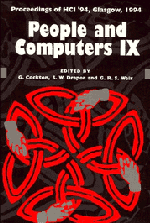Book contents
- Frontmatter
- Contents
- Preface: HCI'94 – You Probably Haven't Seen It All Before
- Part I Invited Papers
- Part II Methodology of Interactive Systems Development
- Crafting Interaction: Styles, Metaphors, Modalities and Agents
- Modelling Humans, Computers and their Interaction
- Notations and Tools for Design
- Part VI Computer-Supported Cooperative Work
- 27 Designing a User Interface for Folding Editors to Support Collaborative Work
- 28 Collaborative Use of X-Windows Applications in Observational Astronomy
- 29 Que Sera Sera — The Problem of the Future Perfect in Open and Cooperative Systems
- 30 Viewpoints, Actionpoints and Spatial Frames for Collaborative User Interfaces
- Author Index
- Keyword Index
30 - Viewpoints, Actionpoints and Spatial Frames for Collaborative User Interfaces
Published online by Cambridge University Press: 04 August 2010
- Frontmatter
- Contents
- Preface: HCI'94 – You Probably Haven't Seen It All Before
- Part I Invited Papers
- Part II Methodology of Interactive Systems Development
- Crafting Interaction: Styles, Metaphors, Modalities and Agents
- Modelling Humans, Computers and their Interaction
- Notations and Tools for Design
- Part VI Computer-Supported Cooperative Work
- 27 Designing a User Interface for Folding Editors to Support Collaborative Work
- 28 Collaborative Use of X-Windows Applications in Observational Astronomy
- 29 Que Sera Sera — The Problem of the Future Perfect in Open and Cooperative Systems
- 30 Viewpoints, Actionpoints and Spatial Frames for Collaborative User Interfaces
- Author Index
- Keyword Index
Summary
Synchronisation is a key issue for collaborative user interfaces. An examination of current approaches, in particular the concept WYSIVVIS and the use of Video as a communication medium, highlights a number of issues in this area including lack of a common spatial frame of reference, lack of appropriate embodiment of users and inflexible and rigid communication channels between users. The paper then proposes a new framework for designing collaborative user interfaces which addresses these issues. This framework is based on the notion of a common spatial frame within which embodied users are free to move autonomously, being casually aware of each other's activities. Embodiment is considered in terms of both individual viewpoints and actionpoints (e.g. telepointers) within the display space. We propose that, in many cases, synchronisation of the spatial frame is necessary but synchronisation of viewpoints and actionpoints may actually inhibit collaboration. We finish by describing some prototype systems which provide one (of possibly many) examples of how our framework might be employed; in this case to create shared cooperative virtual environments.
Keywords: synchronisation, video, WYSIWIS, virtual reality, multi-user interface, computer-supported cooperative work (CSCW).
Introduction
Collaborative user interfaces, particularly shared workspaces, have been the focus of considerable research effort in recent years. Resulting systems include multi-user editors and drawing tools (Ellis, Gibbs & Rein, 1991; Foster & Stefik, 1986; Greenberg & Bohnet, 1991), shared screen systems and more specialised design surfaces (Ishii & Kobayashi, 1992). There has also been a growth in the use of multi-media technology to support communication and awareness between the users of such systems including conferencing systems (Sarin & Greif, 1985) and media-spaces (Gaver et al., 1992; Root, 1988).
- Type
- Chapter
- Information
- People and Computers , pp. 409 - 424Publisher: Cambridge University PressPrint publication year: 1994



